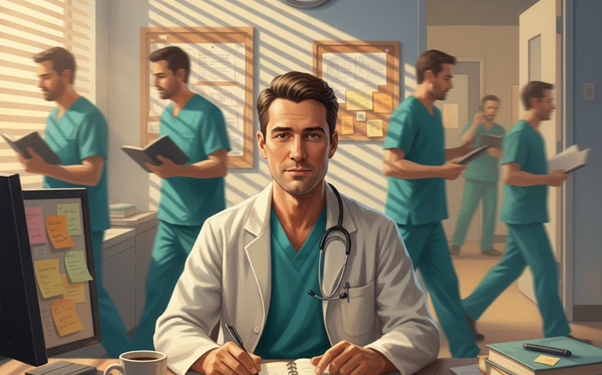TL;DR:
Emergency rooms are drowning because primary care is collapsing on both sides of the border. Patients are older, sicker, more connected, and more impatient. Physicians are fewer, younger, and (wisely) less willing to sacrifice their lives to fix a broken system. The solutions aren’t complicated — just politically inconvenient: pay and support primary care properly, staff ERs safely, and teach patients what real emergencies look like.
I’ve been at this for five decades — twenty years in emergency medicine, thirty in family practice. I’ve worked as a hospitalist, run two nursing homes, and been a patient myself more times than I’d like. I’ve practiced from Ontario to Texas, visited ERs in every province and most U.S. states, and seen the best and worst of both systems.
Thirty-five years ago, when I ran the Oakville ER, the average wait time was one hour. One hour!
Now? In many places — whether Toronto or Tulsa — you can grow old waiting for a bed.
So what happened?
1. More people, fewer family doctors
Both Canada and the U.S. have booming populations, but the number of full-scope family physicians is falling. In Canada, six million people have no primary care doctor. In the U.S., over 100 million Americans lack consistent primary care access. In both countries, that’s a straight pipeline to the ER.
2. Family doctors are working smarter — not longer
Younger doctors want a life outside medicine. Good for them. Bad for systems built on unpaid overtime. When I started, burnout was a badge of honor; now it’s a warning sign. We can’t guilt our way back to 80-hour weeks.
3. Sicker patients, longer lives
Modern medicine works — too well. People now survive heart attacks, cancers, and strokes that once killed them. But survival means complexity: polypharmacy, frailty, and follow-up. The “walking well” have been replaced by the “living complicated.”
4. The Google Effect
Everyone’s a diagnostician now. WebMD and TikTok have replaced the village nurse. Every rash or twitch gets crowdsourced, and most roads lead to “go to the ER.” I’ve done it myself. Guilty as charged.
5. The Uber Eats Mentality
In the age of instant everything, waiting feels like injustice. Sore throat for 15 minutes? Off to urgent care. Cough for two days? “Better get a chest X-ray.” We’re addicted to immediacy, and the system feeds the addiction.
6. The ER as shortcut
Patients have learned the hack: if you go through primary care, it can take weeks for labs or imaging and months for specialists. Go to the ER, and you might get it all in a day. Whether you’re in Ontario or Ohio, the pattern’s the same.
7. The higher bar of care
When I was sharing call with Hippocrates, we had what we called the “mini-waiting room” — 20-odd patients with cuts, sprains, and sniffles. A nurse and I could triage them in minutes.
Now? Documentation, litigation fears, and staffing shortages mean one physician might cover a city of 150,000 after midnight. It’s not heroism; it’s hazard.
8. The collapse of continuity
There was a time when every patient had a family doctor, and you could phone the office, speak to a real human, and be seen the same day. In the U.S., the doctor knew your story because she delivered your baby and treated your father’s diabetes. That continuity is vanishing — replaced by anonymous portals, retail clinics, and bots that never call back.
So what do we do? Practical medicine, not miracles.
1. Pay primary care properly
In Canada, family docs earn a fraction of what specialists do. In the U.S., primary care lags far behind procedural fields.
Solution: Double primary-care pay. It’s still cheaper than ER visits and hospitalizations ten times the cost.
2. Fund the support staff
Family doctors spend about 19 hours a week on unpaid paperwork. In the U.S., it’s the same — just with more forms. Hire scribes, nurses, and medical assistants. Let doctors doctor.
3. Build walk-in clinics beside ERs
See the sprains, UTIs, and pink eyes next door, not in the trauma bay. In the U.S., many hospitals are already doing this — “fast-track” zones save time and money. Canada should copy it shamelessly.
4. Pay ER staff properly
Night shifts, weekends, holidays — pay double. Because replacing burned-out ER docs and nurses costs far more than retaining them.
5. Zero tolerance for abuse
Violence against healthcare workers is epidemic. Whether it’s Boston or Vancouver, it’s time to call the police, press charges, and back our staff. Compassion doesn’t mean cowardice.
6. Empower pharmacists
Pharmacists can treat minor infections, rashes, allergies, and provide vaccines. Pay them per encounter and educate the public. In the U.S., states like Idaho and New Mexico are already leading the way.
7. Teach the public
Mass campaigns explaining where to go, when, and what to bring — meds, allergies, summary list — would save millions of wasted visits. In the U.S., employer-based education could help too.
8. Train more clinicians
Double NP and PA programs. Expand residency slots — the U.S. hasn’t kept up with medical school growth. Canada should do the same.
9. Use technology wisely
AI scribes, voice recognition, and integrated EMRs can cut charting time dramatically. Ontario and several U.S. systems are piloting this — early data show it boosts both accuracy and morale.
The bottom line
The tsunami is here. Boomers are aging, Gen X is next, and the workforce caring for them is shrinking. You can’t build a healthcare system on the unpaid goodwill of exhausted people.
Desperate times don’t just need desperate measures — they need honest ones. Pay fairly. Staff safely. Simplify the paperwork. Respect the front line.
Because when you take care of your doctors, your doctors can take care of everyone else.
Watch out for my upcoming blog series on time management for physicians.
To join the waitlist for my next bestselling course on time management,
